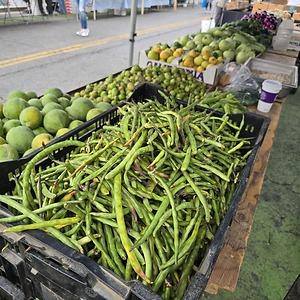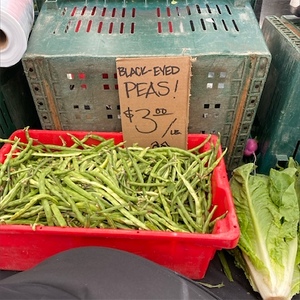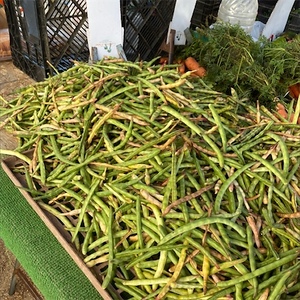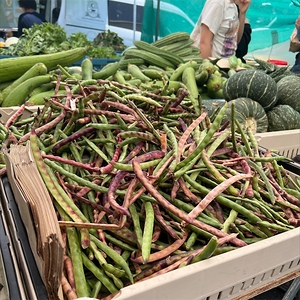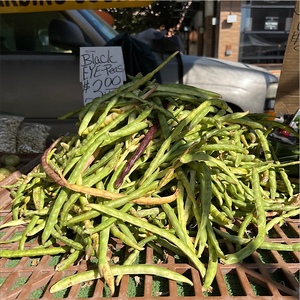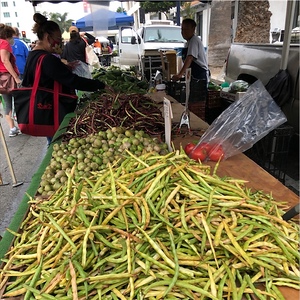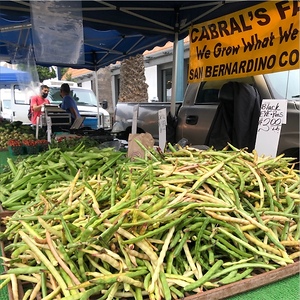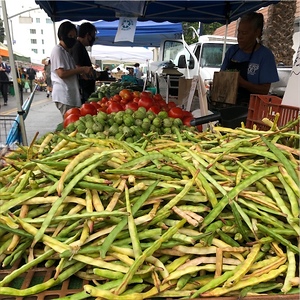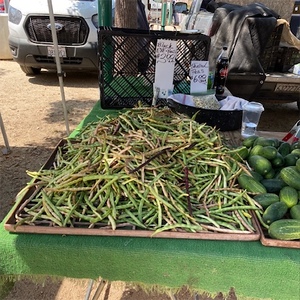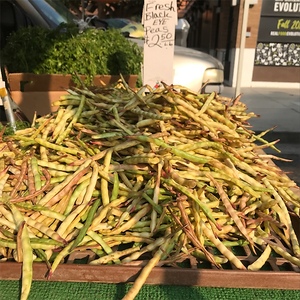


Black-eyed Peas
Estimated Inventory, 10 lbs : 0
Description/Taste
Black-eyed peas are comprised of elongated, narrow pods, averaging 7 to 15 centimeters in length, encasing 6 to 13 oval, slightly curved seeds. The fibrous pods are generally green and are tightly fitted around the seeds, developing a bumpy appearance. Once the pods are removed, the fresh seeds are plump, smooth, and taut, showcasing a cream-colored base with a trademark black-purple circle in the seed's center. This pigmented circle is known as the eye, which is created at the exact point where the bean attaches to the pod. Black-eyed peas have a dense and firm texture, and when cooked, the consistency will soften slightly, developing neutral, nutty, earthy, and savory flavors.
Seasons/Availability
Fresh Black-eyed peas are available in the mid to late summer. Dried versions of the beans are available year-round.
Current Facts
Black-eyed peas, botanically classified as Vigna unguiculata, are a type of legume with edible seeds and pods belonging to the Fabaceae or bean family. The beans received their name from their distinct colored spot on the skin’s surface and are a type of cowpea, one of the most cultivated beans in the world. There are many different varieties of cowpeas ranging in size and coloring, and the beans were naturally developed through years of selective breeding in warm, sun-filled climates. Black-eyed peas have historically been used as animal feed and as a crop to add nitrogen into the soil for better cultivation. Over time, the beans were incorporated into human diets for their nutritious and filling nature. In the modern-day, the California Blackeye is one of the most commercially grown varieties, and Black-eyed peas are utilized throughout both fresh and dried culinary applications worldwide.
Nutritional Value
Black-eyed peas are an excellent source of folate to assist in the production of red blood cells and are rich in copper, magnesium, phosphorus, zinc, and iron. The legumes also provide potassium to balance fluid levels within the body, fiber to stimulate the digestive tract, and lower amounts of vitamin B6, vitamin C, and vitamin A.
Applications
Black-eyed peas are a type of legume that can be consumed both fresh and dried. Young pods and seeds are primarily used for fresh applications, and the seeds can be eaten straight, out-of-hand similarly to edamame. Despite their fresh-eating abilities, Black-eyed peas are mainly dried and utilized in cooked applications such as boiling and steaming. The dried beans can be soaked for 2 to 6 hours to soften and then simmered in broths and stocks for added flavor. Black-eyed peas are popularly incorporated into soups, curries, and stews and are steamed and served as a savory side dish. In the United States, the beans are traditionally cooked with collard greens and pork as a New Year’s meal to bring luck in the year to come. The beans can also be boiled, mashed, and fried into fritters, mixed into rice dishes, tossed into salads, or coated in vinaigrette dressings as an accompaniment to meat dishes. In Southeast Asia, Black-eyed peas are sometimes incorporated into coconut sticky rice as a savory-sweet dessert. The water used to boil the beans is also used as a stock base in other applications. Black-eyed peas pair well with meats such as pork, poultry, and fish, cornbread, tomatoes, aromatics, including garlic, ginger, shallots, and onions, spices such as cumin, oregano, and chili powder, and greens such as arugula, chard, and kale. Fresh Black-eyed peas should be used immediately for the best quality and flavor. Dried Black-eyed peas can be kept in a sealed container for one year in a cool and dry place. The beans can also be frozen in a sealed container for up to 6 months.
Ethnic/Cultural Info
Black-eyed peas are known as Lobia and Karamani in Southern India and are a traditional ingredient incorporated into offerings during the Navratri festival. The name Navrati roughly translates to mean “nine nights” and is a Hindu fall festival that lasts for ten days and nine nights to worship Shakti, the divine mother. In the Hindu religion, Shakti appears in three primary forms, Saraswati, Durga, and Lakshmi, and in Southern India, Saraswati is widely honored through idols, scripture readings, worship, and offerings. Navratri is celebrated differently across India, but Black-eyed peas are a popular prasadam or offering to the gods. Throughout Southern India, families create sundals, small dishes of legumes to use as prasadams and bring them to house gatherings as gifts to the hosts. During the festival, golus are erected in family homes, which are festive shrines featuring figurines to symbolize the structure of life between the gods and man. When sundals are presented to the hosting family, it is a sign of goodwill. The sundal is placed on the golu as an offering and is later consumed as a sign of respect to the gods.
Geography/History
Black-eyed peas are believed to be native to Northern Africa, where they have been growing wild for thousands of years. The ancient legumes are a type of cowpea, which was first domesticated in Western Africa around 3,000 BCE, and over time, many different varieties of Black-eyed peas were created through natural cultivation with varying sizes and colors. Black-eyed peas were introduced to Asia in the Early Ages, and the legumes became naturalized in many warm regions, spanning from China to India. The beans were later introduced to the West Indies, the United States, and South America through European trade routes from Africa in the 17th century. Today Black-eyed peas are grown worldwide and are highly produced for domestic use and export in Africa. The beans are also cultivated in regions of Asia, Europe, North, Central, and South America, the Caribbean, and Australia.
Recipe Ideas
Recipes that include Black-eyed Peas. One



